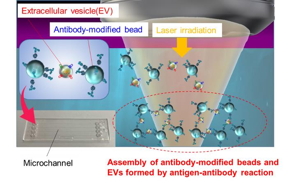Home > Press > Super-efficient laser light-induced detection of cancer cell-derived nanoparticles: Skipping ultracentrifugation, detection time reduced from hours to minutes!
 |
| Using laser irradiation, the researchers managed to directly detect nanoscale EVs in a cell supernatant within minutes.
CREDIT Takuya Iida, Osaka Metropolitan University |
Abstract:
Can particles as minuscule as viruses be detected accurately within a mere 5 minutes? Osaka Metropolitan University scientists say yes, with their innovative method for ultrafast and ultrasensitive quantitative measurement of biological nanoparticles, opening doors for early diagnosis of a broad range of diseases.
Super-efficient laser light-induced detection of cancer cell-derived nanoparticles: Skipping ultracentrifugation, detection time reduced from hours to minutes!
Osaka, Japan | Posted on October 6th, 2023
Nanoscale extracellular vesicles (EVs) including exosomes, with diameters of 50150 nm, play essential roles in intercellular communication and have garnered attention as biomarkers for various diseases and drug delivery capsules. Consequently, the rapid and sensitive detection of nanoscale EVs from trace samples is of vital importance for early diagnosis of intractable diseases such as cancer and Alzheimer’s disease. However, the extraction of nanoscale EVs from cell culture media previously required a complex and time-consuming process involving ultracentrifugation.
A research team led by Director Professor Takuya Iida, Deputy Director Associate Professor Shiho Tokonami, and Assistant Director Professor Ikuhiko Nakase, from the Research Institute for Light-induced Acceleration System (RILACS) at Osaka Metropolitan University, has utilized the power of laser light to accelerate the reaction between nanoscale EVs derived from cancer cells and antibody-modified microparticles. The three-dimensional structure of the resulting aggregates was then analyzed using confocal microscopy. As a result, the researchers demonstrated the ability to measure, within 5 minutes, approximately 103104 nanoscale EVs contained in a 500 nL sample.
Professor Iida concluded, This research achievement provides a method for ultrafast and ultrasensitive quantitative measurement of biological nanoparticles, offering a foundation for innovative analysis of cell-to-cell communication and early diagnosis of various diseases in the future.
####
About Osaka Metropolitan University
Osaka Metropolitan University is the third largest public university in Japan, formed by a merger between Osaka City University and Osaka Prefecture University in 2022. OMU upholds “Convergence of Knowledge” through 11 undergraduate schools, a college, and 15 graduate schools. For more research news, visit https://www.omu.ac.jp/en/ or follow us on Twitter: @OsakaMetUniv_en, or Facebook.
For more information, please click here
Contacts:
Ngoc Han Hoang
Osaka Metropolitan University
Copyright © Osaka Metropolitan University
If you have a comment, please Contact us.
Issuers of news releases, not 7th Wave, Inc. or Nanotechnology Now, are solely responsible for the accuracy of the content.
News and information
![]()
Observation of left and right at nanoscale with optical force October 6th, 2023
![]()
The efficient perovskite cells with a structured anti-reflective layer another step towards commercialization on a wider scale October 6th, 2023
![]()
Successful morphing of inorganic perovskites without damaging their functional properties October 6th, 2023
![]()
Interdisciplinary: Rice team tackles the future of semiconductors Multiferroics could be the key to ultralow-energy computing October 6th, 2023
Cancer
![]()
The medicine of the future could be artificial life forms October 6th, 2023
Possible Futures
![]()
Discovery made by University of Warsaw scientists may enable network interface for quantum computers October 6th, 2023
![]()
The medicine of the future could be artificial life forms October 6th, 2023
![]()
Successful morphing of inorganic perovskites without damaging their functional properties October 6th, 2023
Nanomedicine
![]()
The medicine of the future could be artificial life forms October 6th, 2023
![]()
New compound unleashes the immune system on metastases September 8th, 2023
Discoveries
![]()
A new qubit platform is created atom by atom October 6th, 2023
![]()
Twisted science: NIST researchers find a new quantum ruler to explore exotic matter October 6th, 2023
![]()
Discovery made by University of Warsaw scientists may enable network interface for quantum computers October 6th, 2023
![]()
The medicine of the future could be artificial life forms October 6th, 2023
Announcements
![]()
Observation of left and right at nanoscale with optical force October 6th, 2023
![]()
The efficient perovskite cells with a structured anti-reflective layer another step towards commercialization on a wider scale October 6th, 2023
![]()
A new qubit platform is created atom by atom October 6th, 2023
![]()
Twisted science: NIST researchers find a new quantum ruler to explore exotic matter October 6th, 2023
Interviews/Book Reviews/Essays/Reports/Podcasts/Journals/White papers/Posters
![]()
Observation of left and right at nanoscale with optical force October 6th, 2023
![]()
The efficient perovskite cells with a structured anti-reflective layer another step towards commercialization on a wider scale October 6th, 2023
![]()
A new qubit platform is created atom by atom October 6th, 2023
![]()
Twisted science: NIST researchers find a new quantum ruler to explore exotic matter October 6th, 2023
Nanobiotechnology
![]()
The medicine of the future could be artificial life forms October 6th, 2023
![]()
New compound unleashes the immune system on metastases September 8th, 2023
Photonics/Optics/Lasers
![]()
Ultrafast lasers for materials processing August 11th, 2023
![]()
Femtosecond laser technique births “dancing microrobots”: USTC’s breakthrough in multi-material microfabrication August 11th, 2023










